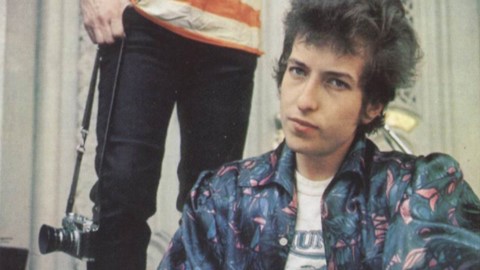Top 10 Bob Dylan Songs

#10: “Knockin’ on Heaven’s Door”
Pat Garrett & Billy the Kid (1973)
Part of the soundtrack for the western “Pat Garrett & Billy the Kid,” which Dylan even had a bit acting part in, this folk rock and gospel tune tells the story of a dying sheriff. Peaking within the Billboard Hot 100’s top twenty, the simple but bitterly poetic melody has also inspired cover versions by Eric Clapton, Guns N’ Roses, U2, and countless others.
#9: “A Hard Rain’s a-Gonna Fall”
The Freewheelin’ Bob Dylan (1963)
One of his most episodic songs, this seven-minute-long entry from Dylan’s breakthrough album seems at first to consist of a series of tales from a distant past. But, as the verses unfold, the imagery becomes increasingly apocalyptic and begins to read more as a warning from the future. Indeed, a month after the song’s debut, the U.S. became engulfed in the Cuban Missile Crises, making it perhaps a bit too on the mark.
#8: “All Along the Watchtower”
John Wesley Harding (1967)
Perhaps the most famous of his songs to become popularized by other artists, Dylan’s original version of “All Along the Watchtower” appeared on his John Wesley Harding album several months before Jimi Hendrix’s electric cover. However, Dylan’s version is still a classic with his shrieking harmonica and some of the most impactful imagery of any of his songs. Like many Dylan tracks, it has been called an antiwar statement, but also like many of his songs, you could never really prove it.
#7: “Mr. Tambourine Man”
Bringing It All Back Home (1965)
With allusions to being “numb” and put under a spell, this song is often considered a metaphor—if a poetic one—for a drug deal. For his part, Dylan has gone on record saying that the folk number is actually about, well, a man who plays a tambourine. Its abstract imagery allows for multiple and individual interpretations, which is what makes it just as interesting nearly 50 years after its release.
#6: “Positively 4th Street”
“Positively 4th Street” single (1965)
Released as a single the same year as landmark albums Highway 61 Revisited and Bringing It All Back Home, this is one everyone can relate to. At his best and bitterest, Dylan laces into a superficial friend—you know the kind that loves you when you’re on top, but is the first to disappear when things go south. He even goes so far as to sing “you’d rather see me paralyzed.” That’s pretty cold, Bob.
#5: “Subterranean Homesick Blues”
Bringing It All Back Home (1965)
Equally famous for its experimental music video, which first appeared in D.A. Pennbaker’s documentary “Dont Look Back,” this track sees Dylan cutting between issues of the times in his fevered, savant-like style. Often—but never easily—imitated, the song draws on scat and R&B influences to create something truly iconoclastic, and has taught young people for generations just exactly what and whom to look out for.
#4: “Tangled Up in Blue”
Blood on the Tracks (1975)
The ‘70s marked a departure from earlier protest hymns to a focus on the personal lives of his subjects. This Blood on the Tracks single captured the many twists and turns of two lives, which become repeatedly entwined. Ever reticent to be labeled the voice of a generation, “Tangled Up in Blue” still hits on something undeniably universal, as the baby boomers struggled to get a foothold in a new decade.
#3: “Blowin’ in the Wind”
The Freewheelin’ Bob Dylan (1963)
One of Dylan’s most earnest and straightforward songs, this one was released during the buildup to the Vietnam War and became a rallying cry of the antiwar movement throughout. Always the contrarian, Dylan insisted it was not a protest song, which was not a little ironic, considering it’s widely recognized as the most important protest song of all time – as well as a valuable civil rights anthem.
#2: “The Times They are a-Changin’”
The Times They are a-Changin’ (1964)
With escalation in Vietnam seemingly inevitable and the assassination of President Kennedy just months earlier, Dylan’s folk masterpiece is both a message of hope and a warning. While imagery like wheels in motion indicate that change is indeed inevitable, Dylan cautions that there will be consequences for those who stand in the way. The struggle between old and new ways that defined so much of the decade was never more perfectly described.
Before we reveal our top pick, here are a few honorable mentions:
- “Just Like a Woman” Blonde on Blonde (1966)
- “Hurricane” Desire (1976)
- “I Shall Be Released” Bob Dylan’s Greatest Hits Vol. II (1971)
- “Shelter from the Storm” Blood on the Tracks (1975)
- “Things Have Changed” Wonder Boys (2000)
- “Highway 61 Revisited” Highway 61 Revisited (1965)
#1: “Like a Rolling Stone”
Highway 61 Revisited (1965)
From the moment the first organ riff sounded, everything changed. Lyrically derisive, and—as his early fans would claim—an outright betrayal, this song bridged the gap between folk and electric, between idol and villain, and between idealism and cynicism. To think it was booed upon its first live performance seems like pure insanity now, but the song represented Dylan’s desire to keep growing as an artist, even if it meant leaving behind those who held him dearest.
Do you agree with our list? Which Dylan songs are closest to your heart? For more iconic top 10s, published daily, keep it tuned to WatchMojo.com.
